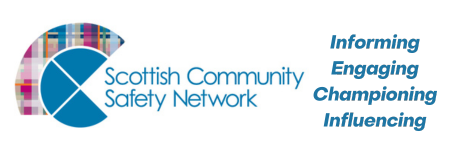
Tricia Spacey is currently working with SCSN on secondment from Fife Council on Safer Communities Improvement and Partnerships. At the end of 2018, she wrote a short blog post on her thoughts so far.
Firstly a little introduction….I have worked in community safety in Fife since 2001, until 2015 within a policy role and the last couple of years as a Team Manager within the operational Safer Communities Team. While I enjoy my role with the SCT, I have missed policy so welcomed the opportunity this secondment offers to return to my policy, strategic roots. I also really wanted the opportunity to experience life within the Scottish Government. I studied Politics at University (albeit a few years) and it is world which has always fascinated me.
I am surprised at the structure/set up of Building Safer Communities. The wider Safer Communities Division is huge and I can see potential for more joined up working both within the division itself and across to others. Already I have identified potential for closer working links between BSC and Housing.
So what is it I am here to do… My role is to build on the recommendations within the report ‘Community Safety – the emerging landscape and future opportunities’ – look at how to improve connections between local and national initiatives and activity, help shape the future priorities for the Building Safer Communities programme, and what has become one of my main tasks – support the development of a ‘community safety narrative’.
The development of my work plan has been a task in itself! I have struggled with the concept of a ‘community safety narrative’. Lorraine (SCSN) and Elinor (BSC, Scottish Government) have been very helpful (and patient) in supporting me to work this through. I think I have got it now and hope to produce a narrative which will:
- Outline the community safety landscape and the relationship between key policy and legislative strands
- Identify cross policy themes, raising awareness of the importance of links with community safety and supporting community safety partners to ‘make the case’ for community safety
- Outline current and emerging legislation/themes will which impact community safety
I have my own ideas as to what key legislative strands and policy themes to look at (National Performance Framework, Justice Vision, Fairer Scotland, ACE’s/Trauma, Health (Public Health, Health and Justice), but really want to get out and about to speak to other people to get their ideas.
I haven’t only spent my time so far trying to understand what a ‘narrative is – I have done some other things! My role around unintentional harm has been an easier one – in terms of my own understanding – but challenging in other ways! I have worked to address unintentional harm in Fife for as long as I have worked in community safety. I fought the battle to get this work raised to the level (in terms of interest and resourcing) of other more ‘traditional’ community safety work areas and welcomed the development of Building Safer Communities Phase 2. My role here is to support the development of the online hub. I am working with BSC colleagues to create practice exemplar template and criteria and used my local experience in managing a unintentional harm service to have a go at completing the template and feedback how I found it. I have also got responsibility for trying to get some practice exemplars from colleagues across Scotland.
This task isn’t easy –areas are slow in coming back with examples – there is a lot of emailing and chasing people up. My initial thoughts were that the focus should be less on best or good practice but more on just encouraging people to tell us what they are doing. But I have realised this is me thinking with my local head on –I am understanding that nationally the government have a role to play to supporting colleagues to identify and share what is working well. This task is giving me food for thought and encourages me to see things from all sides.
I have enjoyed doing a few specific SCSN related tasks – one of my first being to write a briefing paper on the National Performance Framework. This not only increased my knowledge about the NPF but also got me back into the swing of writing reports. As did writing the CCTV Project Advisory Board PID –I had no idea what a PID was – but I did one! Supporting the screening of the ‘Resilience Film’ was great. When I first saw this film, it was a lightbulb moment for me, it makes so much sense and like many who see it, I have been on a crusade ever since to make other see it, so being part of a screening for community safety colleagues (all other times I have seen it have been part of community justice or education discussions) was a really interesting, inspiring experience. I hope this is just the start of many discussions.
What I really want to get out this secondment is to produce something which helps people see the importance of community safety – while it may not appear explicitly within LOIPS and there may not be the same local structures and governance there once was – the need to ensure we have safe, resilient communities has not disappeared.
